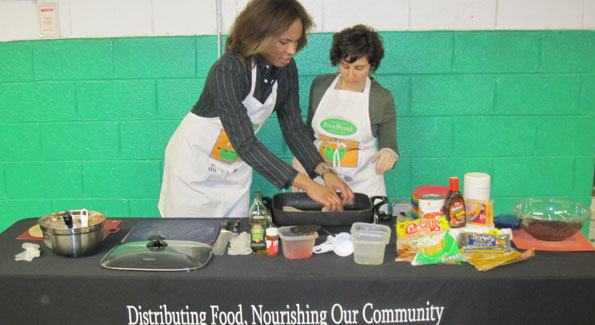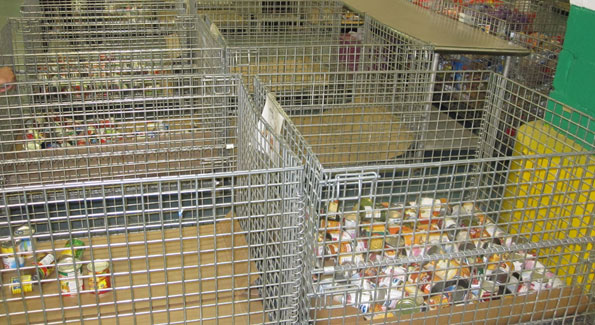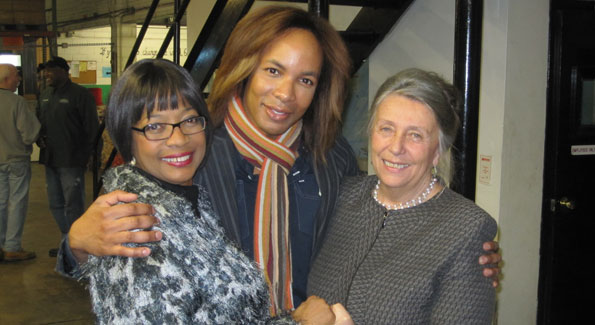But nearly one in two of the District’s kids under age 18 is still at risk for being hungry.
By Jane Hess Collins

Paul Wharton and CAFB Nutrition Education Director Jodi Balis demonstrate how to create a delicious meal for under $16.00.
Makeover guru and celebrity Paul Wharton is a nice guy. He takes his mother to the BET Awards. He’s the Capital Area Food Bank (CAFB)’s Ambassador Against Hunger. And most of all, he genuinely cares about ending hunger in Washington, DC.
“Food is a big part of showing people that you care,” Wharton said. Born in Cleveland, Ohio, he recalled how family gatherings revolved around huge meals. That connection influenced his passion for helping the area’s hungry.
Since “the face of hunger can be my friends, my neighbors, people in our own family,” Wharton has set out to represent “the people with no voice” and to set an example for the rest of the nation by showing others how they can help and get involved.
Founded in 1980, the CAFB distributed 27 million pounds of food last year, including 10.8 million pounds of fresh produce, through direct service or through their network of 700 nonprofit partners. Last year CAFB served 474,000 people in the greater DC area, but they estimate that another 200,000 citizens are still hungry.
The food distributed by the CAFB is a far cry from the food banks of Wharton’s youth. He remembered “a block of cheese and stale white bread” from his days as a food bank volunteer with his mother’s church. The CAFB food, Wharton said, is “the food that you and I walk by in Whole Foods.”
CAFB food comes from all major grocery chains, as well as local farmers, according to Lynn Brantley, President and CEO of the CAFB. None of the donated food has expired, but it might have a dent in the box or can. “But,” Brantley added, “These are very, very tough days.” Just the high price of oil and gas has raised food costs over 10 percent since February.
“Our children are suffering in the economic downturn,” Brantley said. Plenty of studies from Tufts University show a link between poor nutrition and a negative impact on children’s ability to learn, she said, and the 2010 Census showed that almost half of the District’s children are at risk of hunger, meaning they don’t have access to three nutritious meals a day.
To combat that, CAFB programs focus after-school kid programs, nutrition, and helping clients plan meals with only $16 of groceries-roughly the weekly food stamp allotment for each member of a four-person family.

Near-empty food bins at the Capital Area Food Bank. Food donations are dangerously low this time of year.
Most surprising during the CAFB tour were the acres of empty food bins. “Everyone thinks about hunger during the holiday season, but after the holidays, the food supply dries up,” Wharton said. While the 14,000 volunteers save the CAFB $1.7 million annually, the problem at hand is having enough food available.
What’s a volunteer to do? A donation of only a dollar can provide three meals.
Wharton has been encouraging his peers to donate $5 since he participated in the “Skip lunch can feed a bunch” public service announcement three years ago that provided 240,000 meals. Volunteers can also organize food drives for the CAFB, or attend the annual Blue Jeans Ball on April 10.
And how does he see as his role as the CAFB Ambassador Against Hunger? “I want people to know that we are able to get in front of this problem and really work towards decreasing hunger in our city,” he said.
“This is the most powerful city in the world.
We do amazing things. The world watches what we do and I want to set an example for the rest of the nation through the work that we’re doing here.”
He summed it up with, “You can’t really be your best if you’re filled with junk.”
Get Out and Give Back is now on Facebook. Jane Hess Collins helps and encourages people to give back through her writing, speaking, coaching and workshops.
She also established game nights for at-risk families throughout the country. You can contact her at www.getoutandgiveback.com.

